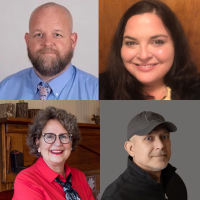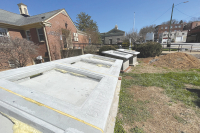Green gas heavy metal: Jackson’s County’s Green Energy Park offers methane-fired blacksmith forge
By Anna Fariello • Guest Writer
William Rogers has been a professional metalsmith for more than 25 years, but nothing could have prepared him for the work he is doing at the Jackson County Green Energy Park.
“Coal has always been the traditional fuel of blacksmiths. There’s a kind of symmetry there — black metal, black fuel,” he said.
But no longer.
Last fall Rogers may have fired up the first methane-fueled blacksmithing forge in the United States. While word is slowly filtering through the metals community, the Environmental Protection Agency has taken notice. The EPA recently named the park the Landfill Program Project of the Year. Located in Dillsboro, the Jackson County Green Energy Park may serve as a model for other methane conversion projects.
Related Items
An end product of decomposition, methane is a potent greenhouse gas. The “green” in the Green Energy Park converts “black” smithing by using gases that typically build up underground in community landfills. Because landfill gasses cannot be allowed to flow freely into the atmosphere without environmental consequence, methane is usually burned off in a flare. An “eternal flame” that burns off methane emissions marks many landfills. Nationwide, innovative communities are experimenting with converting methane to a useable fuel.
Rogers, a relative newcomer to Western North Carolina, brings a range of experience as a consultant to the Green Energy Park. Early in his career, he helped set up a blacksmithing studio at the Appalachian Center for Crafts in Smithville, Tenn., with famed smith Francis Whitaker. His college metals teacher was a German silversmith.
“Both were very demanding teachers,” Rogers said, and both filled him with determination. But where to begin with methane was still a challenge. “I decided I had better check out what resources were out there.”
He studied the Energy Xchange project in Yancey County and visited the University of North Carolina-Asheville campus. There he talked with metal sculptor Dan Millspaugh about the gas-fired forge on campus. He learned that plans for a new UNC-A “craft campus” include the use of methane as an alternative fuel, but Rogers soon found out that that plan is years in the making.
“I was on a deadline and had to keep moving forward,” he said.
Rogers then contacted Ken Mankel, whose Michigan-based Mankel Forge Co. held the most promise for methane conversion.
“Mankel makes a natural gas forge that seemed the best starting point for conversion,” he said.
Still, there were adjustments that had to be made, first to the forge and then to the blower that provides air to create an efficient flame. He conducted numerous tests, adjusting the fuel-to-air ratio until he had it right.
“When the flame climbs out of the forge seeking oxygen, it makes for nice photographs, but that’s not what’s needed in the studio,” he said.
With flames licking out from around the firebox, the forge looks hot to a novice. A professional eye, however, can see that the fire won’t provide enough heat to thoroughly forge a piece of steel. To work steel hot, a smith likes to be able to achieve 2000 degrees Fahrenheit, visible as white hot to the naked eye. Rogers’ first attempts got the metal up to a dull orange. Working several hectic months to meet Jackson County’s deadline, Rogers had the forge up and running at the right temperature for the formal opening of the park in October.
“The only other time I didn’t use coal as a fuel was for a one-semester course I taught at the University of Panama. There, they didn’t have much of anything in the way of studio equipment, so I had to improvise. I locked down a hammerhead in a vise to serve as an anvil and used an oxy-acetylene torch as fuel. I wouldn’t recommend it.”
Aside from this experience in making do, Rogers said that he’s had the good fortune to work in a number of very well-equipped regional studios. He’s demonstrated at the Penland School of Crafts and teaches annually at the John C. Campbell Folk School and the Appalachian Center.
“All three studios are different,” he said. “There is a lot to know about studio set-up, safety, and maintenance, especially in a teaching situation.”
And teaching is what Rogers likes to do best. Before moving to North Carolina, he maintained William S. Rogers Metals studio in Virginia, working on commissions, restorations, and taking private students. He participated in the art outreach programs of the Virginia Museum of Fine Arts and the Virginia Commission for the Arts and was named Master Craftsman by the Virginia Foundation for the Humanities. He taught for three years at Blacksburg High School, named one of the 100 best high schools in the country. For one unit of the art curriculum, he set up a temporary forge on the school patio.
“When the superintendent of schools showed up, I was nervous, but I soon found out he just wanted to be a part of the action,” Rogers said.
Here in Western North Carolina, Rogers is teaching for the Heritage Arts program at Southwest Community College.
The Jackson County Green Energy Park’s metals studio is the first studio in a planned Artisan Village that will eventually include studios for ceramics and glass as well as a greenhouse complex. Beside the smithy, Smoky Mountain Biofuels Inc. makes and sells biodiesel.









